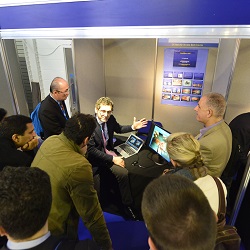
Described as “one of the best” courses of its kind in Europe, this year’s CX Vascular Access Skills course took delegates through each stage of the patient journey, from diagnosis, to treatment, to complication response, through a series of 20 specialist training stations.
“Our main aim was to expose all of the delegates to the different aspects of vascular access,” course director Domenico Valenti (London, UK) told CX Daily News. “Every stage of each procedure, diagnostic tool or endovascular treatment is presented here, which gives delegates a perfect journey.” Describing the set-up of the event as an “IKEA-style pathway” through the patient journey—where attendees walk through aisles of ultrasound workstations, arteriovenous fistula techniques ultrasound assessments, and dialysis tools—Valenti highlighted the holistic and comprehensive nature of the course. “You start with the diagnostic area, then you see all the different surgical treatments, and then you can learn how to rescue various complications in angioplasty.”
Asked which area he was most excited about this year, Valenti described the decision as impossible, “Every station has got its own kudos, and they are all exciting,” he said. The main benefits of the Course in his view were “the direct involvement and the hands-on experience,” he said. “If a delegate wants to learn how to scan—perfection of which is really a skill—this is the right place to do it. It is one of the best—and perhaps the only—courses of this type in Europe. It is not only for trainees that want to see how to perform a technique, but also for established physicians, who want to improve their skills.”
The structure of the Skills Course—of which Nicholas Inston (Birmingham, UK) was also a course director—was praised by Jason Wilkins (London, UK). “I think the way it is set up—where you can start with a patient who is not beyond dialysis, and look at the work-up and go through the whole patient journey—is a very nice idea,” he said. “You will find nurses who want the start and maybe the end of a needling, you will find doctors and surgeons who want a bit of access creation, a bit of thrombectomy and maybe some angioplasty, and they can pick what they need. At the same time, they see what the other bits of the pathway are and just refresh their understanding. I think that is very useful.”
Wilkins and Robert Jones (Birmingham, UK) were demonstrating various thrombosis diagnostic and treatment equipment to delegates. “We trying to illustrate that there are different kinds of devices; they work on different principles, they have been in different types of access and thrombosis, and sometimes they are complementary, so you may need to use more than one piece of kit,” Wilkins explained.
One of the most exciting stations launched the new Super HeRo graft—an update on the HeRo graft—from Merit Medical. “The introduction of Super HeRo means that we no longer have to do that graft to graft anastomosis,” demonstrator James Gilbert (Oxford, UK) explained. “With the Super HeRo graft you get a universal connector that is separate to the graft itself. One half connects to onto your outflow and you can connect the graft of your choice onto the axial. So, I can take an early cannulation fixing graft, slide it on, and it will clamp around the connector. So, fewer decisions for the surgery, less anastomosis work, and you have got a more durable graft in place from the word ‘go’.”
The CX Vascular Access Skills Course, he said, offered “an opportunity to speak to experts and get information, hints, tips and tricks; to give physicians confidence in their practice. In a way, you kind of provide a proctoring service.”
Praising the CX Vascular Access Course more generally, Jones called the sessions “very informative.” “They were very focused on one specific issue to do with access, and I think everyone has gotten a lot out of it,” he said.
“When you have a focus, you really cover the whole topic properly before you move on,” Wilkins added. “Everyone here knows all the basics. They do not need that. They do need insights from centres who do high-volume work and who have specific approaches, and you do not get that anywhere else.”
Commending the multidisciplinary approach, Jones said, “I think each specialty brings its own slant to the table. So, if you are not a surgeon, you get the surgical perspective. If you are not a radiologist, you get a radiological perspective. I think that will enhance everybody’s practice, no matter what they do; surgeons, physicians, nurses, radiologists.”
Expressing his agreement, Wilkins said, “Access, especially, is very multidisciplinary. Nurses might be doing the needling and the surveillance, for example. If you have nurses who do not understand what has happened before access or what happens after—if they do not have that familiarity—then they cannot talk to their patients. As the main contact for much of the patient’s life, it all matters.”







